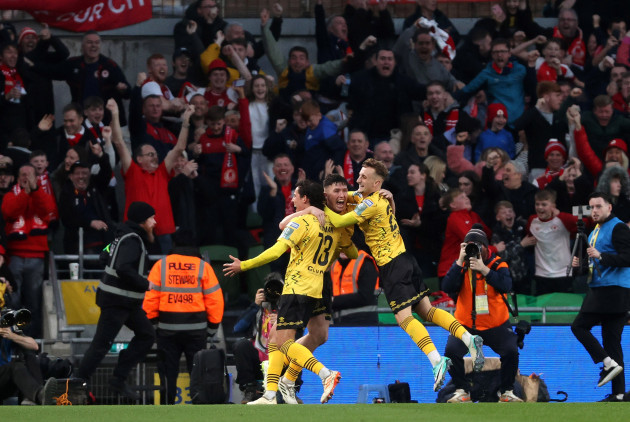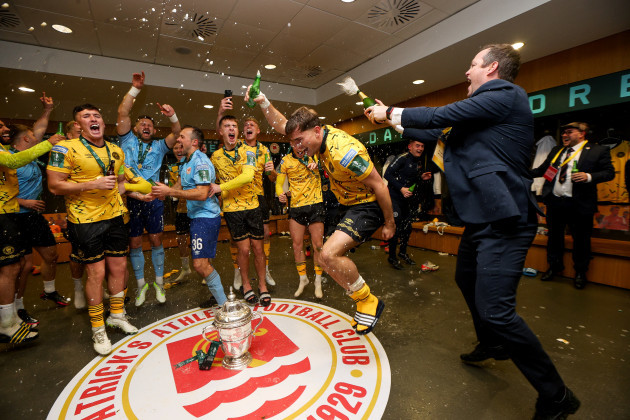PICTURE IT LIKE the final scene in Smiley’s People, as George Smiley stands aloof, watching with a queasy ambivalence the apprehending of his long-time nemesis Karla on a bridge.
‘George, you won’, says his colleague, Peter Guillam.
‘Did I?’, he replied. ‘Yes. Yes, well, I suppose I did.’
For on Sunday a bridge was crossed here too: Official Ireland has turned its voracious eyes upon the League of Ireland.
Mainstream acceptance in Ireland is judged by the extent to which one’s culture is absorbed by our neoliberal ideologues, and Sunday’s FAI Cup final passed the test even before the game kicked off, when MyHome.ie hopped on for some bandwagon marketing to advertise five properties on sale in Phibsboro and Inchicore.
A record crowd of 43,881 people then turned up for the game to light flares, sing songs and generally coo about the quality of the occasion, making it the ninth-best attended domestic cup final across all of Europe this year. When Pat’s won the cup at the Aviva in 2014, only 17,038 people showed up. That victory ended a 53-year Pat’s famine, whereas last Sunday’s triumph was their second in three years.
So what is going on here? How has the League of Ireland, which for decades has been traduced, begrudged, and starved by its own association and State, become so damn popular?
Sunday’s FAI Cup final crowd benefitted from our native genius for bandwagoning on national events, of course, but it has built itself into earning the status of national event. The boom in the cup final crowd reflects one across the League of Ireland as a whole.
Across the last six seasons not affected by Covid restrictions, crowds at matches in the Premier Division and First Division are up 126%. The greatest part of the credit for this should go to the clubs themselves. Those still scratching at the scars will remember that at the start of this six-season stretch the FAI paid a marketing consultant to boost the LOI, and his ideas included the painting of bus stops in club colours; the display of live scores at bus stops; and some non-bus stop related proposals, all delivered with the twin rallying calls of “things are not that bleak” and “as a brand, the league delivers, it’s cool”.
Not That Bleak would even lose a slogan-off to Team of Us.
The new FAI regime has put added emphasis on the LOI, so it would be churlish to deny them a share of the credit for Sunday’s showpiece, but The Old FAI was such that clubs simply mostly had to get along by themselves.
Sunday’s finalists have been at the forefront in the renewal of their clubs as focal points of their communities. This is a powerful thing: give your people an outlet and a unifying identity, and they will respond in turn. Most LOI clubs now exist in their communities on every day of the week, rather than just when they crank the floodlights on every second Friday. The average crowds at Bohs and Pat’s would be bigger were it not for the limitations of their facilities.
The crowd boom is built on other layers, too. The terrace culture is unlike anything else in Irish sport, and is informed much less by English football than it is by central and eastern Europe.
In some parts of the country, LOI clubs have provided an alternative for the floating voter at a time the GAA have inexplicably relaxed into complacency and away from the paranoia that was once their governing principle.
GAA ticket prices are now rising for a spectacle that’s getting worse and involving players and managers who have zero interest in doing interviews to promote their sport and share their stories. By contrast, at LOI level, tickets are cheap, the spectacle is solid and clubs, managers, and players have remained broadly accessible to the media.
It is always difficult to compare the standard of the league in one year as opposed to the other: its best gauge are results in Europe, which were very good last year but extremely poor this time around. What is inarguable is that the composition of squads has greatly changed. The average of age of players has plummeted, and per Uefa’s most recent benchmarking report, only the Latvian league had a higher proportion of minutes played by U23 players in 2022.
This is a consequence of Brexit: with Irish kids no longer able to cross the channel at 16, more are being promoted to their first teams here, particularly as the FAI remain too broke to offer an underage league above U19. (There are plans afoot to regrade that league to U20.) This, combined with the fact that Stephen Kenny has been so willing to cap young players, means that there’s a good chance that whenever you go to an LOI match, you can plausibly claim to be watching a future Irish international. Gavin Bazunu, Evan Ferguson, Andrew Moran: this list is growing annually. Expect Sam Curtis to be adding to it soon.
Six years on, we can say Brexit’s most positive legacies are blue passports and a boom in Irish domestic football. Cheers, Nigel.
Stephen Kenny said a couple of years ago that we should stop considering the League of Ireland as something separate and distinct from the Irish national team or indeed football as a whole, and the dissolving of these old borders has also fed into the boom.
The LOI can only thrive by positioning itself as something distinct from the Premier League, but for years it looked at English football as the GAA once looked at football as a whole, treating it with hostility and guilt-tripping those who deigned to partake.
LOI clubs have now wisely recoiled from ‘proper football’ slogans, and it’s already impossible to imagine anyone repeating Dermot Keely’s ’42,000 morons watching Liverpool’s reserve team’.
Instead, the Premier League now does the differentiating. It has become so expensive and unmoored from reality that it is better understood less as a football competition but as a camp reality television show with a bountiful supply of absurd characters, repulsive practices, and deliciously magnetic spectacles.
The LOI provides something different but, crucially, complementary.
So this isn’t a parable of ‘build it and they will come.’
No, hardly anything is built, and yet still they come. It’s a stirring success story.
– Updated 12.15pm: An earlier version of this article incorrectly stated that St Patrick’s Athletic won the FAI Cup in 2013 and the length of time between their wins in the competition; they won it in 2014, ending a 53-year wait.






